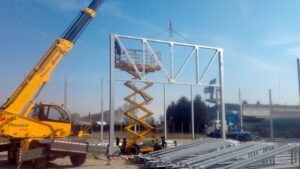the application of chemical nickel plating in the carpentry industry can play several crucial roles. First, it can be used to improve the corrosion resistance of metal components, such as railings, parapets, supports, and support structures. This is especially important when such structures are exposed to weather and moisture, as is often the case in outdoor structures or industrial environments. Chemical nickel plating forms a protective layer on the surface of the metal, which protects it from oxidation and corrosion, prolonging its life and reducing the need for maintenance.

How do they use Chemical Nickel Plating in the carpentry industry?
In the carpentry industry, chemical nickel plating is mainly used to impart corrosion protection and improve the aesthetic appearance of metal components. This process is used on a wide range of structural components, such as railings, parapets, supports, connectors and other carpentry elements exposed to the elements. Nickel plating creates an even protective layer on the surface of the metal, preventing rusting and prolonging its life. In addition, it can be used for decorative purposes, imparting a shiny, reflective appearance to components, thus improving the overall aesthetics of carpentry structures.
What are the advantages of Chemical Nickel Plating in the carpentry industry?
here is a detailed explanation of the points presented in the lineup:
Reliable Protection:
Chemical nickel plating offers safe protection against corrosion and extreme weathering, such as rain, humidity and temperature variations. This means that carpentry components will be less susceptible to rust and corrosion over time, thus reducing the need for costly maintenance and replacement.
Improved aesthetics:
The nickel-plated finish gives an aesthetically pleasing appearance to carpentry structures, giving them a bright, reflective and professional appearance. This not only improves the outward appearance of structures, but also offers greater flexibility in design, adapting to a wide range of architectural styles and aesthetic preferences.
Strength and durability:
Chemical nickel plating increases the resistance of carpentry components to wear and chemical agents, thus providing greater durability and structural stability over time. This means that the structures will be able to maintain their performance and integrity, even in environments subject to high mechanical stress or exposed to corrosive substances.
Additional properties:
In addition to corrosion protection, chemical nickel plating offers additional benefits, such as improved electrical and thermal properties of carpentry components, as well as compatibility with other finishing processes, thus providing greater versatility and adaptability to specific project requirements.
Enhanced functionality:
Chemical nickel plating helps improve the performance and operational efficiency of carpentry structures, reducing friction and wear on moving components and ensuring smoother and longer-lasting operation.
In conclusion, chemical nickel plating provides a comprehensive and versatile solution to protect, improve and extend the service life of carpentry structures, offering a combination of aesthetic, functional and durability benefits.
In the future, how useful will chemical nickel plating be in the carpentry industry?
In the future, chemical nickel plating will maintain its relevance in the carpentry industry, although new approaches and challenges may emerge to address. Imagine a future in which technology is constantly advancing: we may see the development of more efficient and environmentally friendly chemical nickel plating processes. These could offer greater control over coating thickness and uniformity, providing greater durability and corrosion resistance of carpentry components.
Also, with an increasing focus on environmental sustainability, we may see the adoption of more eco-friendly chemical nickel plating solutions, using less toxic electrolytes and implementing more efficient waste treatment systems. This would not only reduce the environmental impact of the nickel-plating process, but could also help improve the image and reputation of the carpentry industry.
At the same time, in the context of an ever-changing landscape of design trends and aesthetic preferences, chemical nickel plating could be used in innovative ways to create unique and customized visual effects on carpentry structures. This could include the use of matte or iridescent finishes, or the integration of different materials and textures to add visual interest and aesthetic value to carpentry projects.
Finally, as technologies and materials evolve, we may see the emergence of new specialized applications for chemical nickel plating in carpentry. This could include the protection of components used in high-tech industries or in particularly aggressive environments, where corrosion resistance is essential for the durability and safety of structures.

